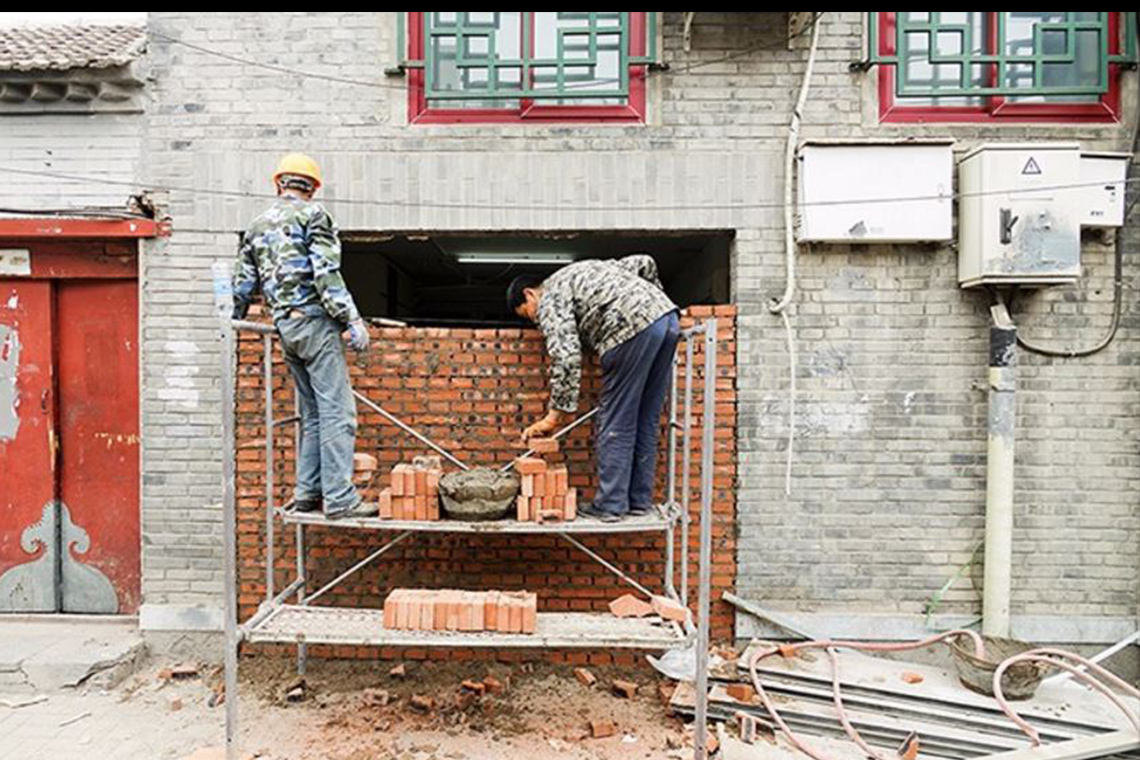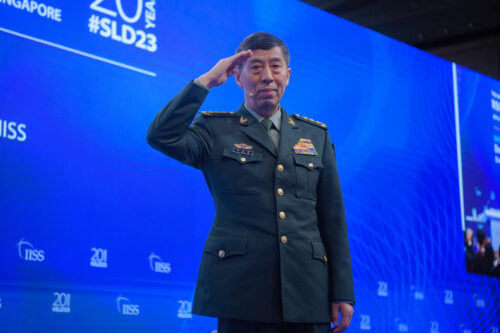South China Sea: Does China have ‘contempt for other nations’ interests’ or is the U.S. ‘irresponsible’?
A roundup of the top China news for June 5, 2017. Get this free daily digest delivered to your inbox by signing up at supchina.com/subscribe.

U.S. and China trade barbs on South China Sea
China’s foreign ministry published a statement (in Chinese) on its website expressing “strong dissatisfaction and determined opposition” to “irresponsible” remarks by U.S. Secretary of Defense James Mattis. Speaking at the Shangri-La Dialogue, an annual conference on Asian security issues that took place in Singapore over the weekend, Mattis said that “artificial island construction and indisputable militarization of facilities on features in international waters undermine regional stability,” and that China’s construction activities in the South China Sea were unique because of “the nature of its militarization, China’s disregard for international law, its contempt for other nations’ interests, and its efforts to dismiss non-adversarial resolution of issues.”
The Nikkei Asian Review says that China had “attempted to strike a more conciliatory tone in this year’s Shangri-La Dialogue,” but that “officials’ uncompromising comments on Taiwan and the South China Sea only highlighted its rifts with the international community.”
You can read Mattis’s whole speech on the website of the U.S. Department of Defense. There is a chaotic but interesting timeline of comments from the Shangri-La Dialogue on the Twitter hashtag #SLD.
Concern about Chinese influence in Australia
“Donald Trump is not the cause of the United States’ problems with China, but he makes them worse,” says Hugh White, a professor at the Strategic and Defence Studies Centre of the Australian National University. White believes this has “big implications for how Australia and others in Asia think about future relations with China,” and argues that part of the solution to American unreliability in the Asia-Pacific region is to “get closer to China.” But getting close to China will be difficult for Australians, as these stories show:
- In a long feature story, the Canberra Times says “the Chinese Communist Party is waging a covert campaign of influence in Australia,” in which “loyalists are rewarded, dissidents live in fear.” The article says that the campaign includes “attempts to influence Australian politicians via political donors closely aligned with the Communist Party,” and attempts to control Chinese citizens “on university campuses, in the Chinese-language media and in some community groups” by coercion and persuasion.
- The Guardian reports that the Commonwealth Scientific and Industrial Research Organisation (CSIRO), an Australian federal government agency for scientific research, is “in a research partnership with a Chinese state-owned enterprise responsible for the same advanced military technologies Australia’s intelligence community is working hard to guard against.” The authors of the article question “whether the relationship underwent the appropriate security checks.”
Twenty-eight years later
June 4 is a yearly reminder of the bifurcated mediascape of the China-watcher: The anniversary of the protests and crackdown in Beijing and across China in 1989 are diligently commemorated outside of China, but within the Great Firewall, there is scarcely a peep.
- In Hong Kong, the annual candlelit vigil at Victoria Park to commemorate June 4 drew 110,000 people, according to organizers, which the South China Morning Post says is “the lowest turnout since 2008.” Last year’s memorial drew 125,000 people.
- The Washington Post reports that “police detained at least 11 Chinese activists after a pair of small events to commemorate the 28th anniversary of the bloody crackdown.”
- TechCrunch notes that social media platform Weibo “clamped down on all overseas users with a ban on uploading images and videos from Saturday until the end of Monday,” presumably a move to hinder the spread of memes and photographs, which are more difficult to filter and censor than text postings.
- The China Project editor-at-large John Pomfret has published his eyewitness account of the June 4 crackdown in Beijing, excerpted from his book Chinese Lessons.
When you need to find the website of the Chinese Weapon Procurement Network…
The Jamestown Foundation has published a useful list of websites of Communist Party, state, and military organizations and news sources.
What’s happening to Beijing’s hutongs?
Beijing is cleaning up what’s left of its most characteristic neighborhoods: the hutongs (alleyways) at the heart of the city. The campaign is intended to beautify, but critics say it will destroy the charm of the old city, and many small-business owners are being forced to close shop. That’s Beijing has published a series of photos and descriptions of the changes and short interviews with people who live and work in hutongs.
—Jeremy Goldkorn, Editor-in-Chief
The Caixin-Sinica Business Brief: Episode 8
Hear Kaiser Kuo, Ada Shen, and Caixin editors narrate and discuss the week’s biggest China business stories. The eighth installment includes stories on the massive corruption case of Wang Bao’an 王保安, how gambling debts led to the suspension of a top table-tennis coach, plus conversations with Doug Young on medical equipment manufacturing and Poornima Weerasekara about the full-size Titanic replica in landlocked Sichuan Province.
This issue of the The China Project newsletter was produced by Sky Canaves, Lucas Niewenhuis, Jia Guo, and Jiayun Feng. More China stories worth your time are curated below, with the most important ones at the top of each section.
BUSINESS AND TECHNOLOGY:
LeEco: Dumpster fire flames get higher
LeEco was founded as a streaming video company in 2004 by Jia Yueting 贾跃亭, an entrepreneur who started his career working in a humble local tax office in Shanxi Province and — through a string of businesses in coal, mobile phones, and internet — built a fortune estimated at 42 billion yuan ($6.2 billion) by Hurun, a company that compiles lists of wealthy Chinese people.
Jia is not known for his modesty: In 2016, he told CNBC that Apple was “outdated” and that “their innovation has become extremely slow.” At the same time, Jia was promising investors and the media that LeEco would deliver a huge new range of products, including drones, electric and self-driving cars, “smart” bikes, and VR headsets, while simultaneously launching an ambitious expansion program in the U.S.
There does not seem to be enough cash in LeEco’s coffers to realize any of Jia’s plans. Last month, TechCrunch reported that “after a months-long parade of endless red flags…the company announced that it would be laying off 325 employees in the U.S. alone.” On June 3, the New York Times said (paywall) that LeEco “has turned to murky and potentially risky ways to stay afloat, including tapping China’s shadowy informal banking system.” Despite its deteriorating financial situation, “the company courted small investors by promising good rates of return and playing down risks” even as it “filled the lobby of its offices with potted plants to keep angry creditors from loitering there.”
- Kushners hunting hard for a loan to pay back Chinese investors / Bloomberg
“The Kushner family real estate company is seeking a $250 million loan to pay back Chinese investors in a New Jersey luxury tower but finding some major U.S. banks wary of the controversies around its White House links and the visa program used to attract the investors.” - Chinese billionaire adds Rock ’n’ Roll marathons to growing Ironman empire / NYT (paywall)
- Silk Road hub or tax haven? China’s new border trade zone may be less than it seems / Reuters
- Chinese automakers struggle to pull off American dream / Caixin
- As China eyes trade growth, Europe moves to calm wary industries / Bloomberg
- The cat-and-mouse game in China’s fight against debt addiction / Caixin
POLITICS AND CURRENT AFFAIRS:
Muslims in Xinjiang up to age 16 must change ‘overly religious’ names
A ban on “overly religious” baby names in the Xinjiang Uyghur Autonomous Region that The China Project noted on April 25 has now been extended to all children up to age 16, the Guardian reports. Names outlawed include Islam, Quran, Mecca, Jihad, Imam, Saddam, Hajj, Medina, and Arafat — children with such names will have to change them before they receive their national identification cards at age 16.
For more on the politics of religious names among Xinjiang’s Uyghurs and a complete list of banned names, see this piece by the anthropology researcher Darren Byler in the Milestones journal.
The Guardian says that the new name ban “coincided with millions gathering at 50,000 individual rallies across Xinjiang this week.” State media reported that “more than a quarter of the region’s population sang the national anthem at 9am on May 29 and pledged allegiance to the Communist Party.” Last month, The China Project noted reports that Xinjiang authorities purchased $8.7 million in DNA-testing equipment for a large-scale collection, far more than any other region in the country.
- Wasted green power tests China’s energy leadership / ABC
ABC notes that despite building more renewable energy than any other country, China “struggles to integrate wind and solar farms into an outdated and balkanized electricity network dominated by coal.” The China Project last month reported on the significant “curtailment” issues in China’s solar power, when electricity that is generated never makes it to end users. - Turning against Trump: How the Chinese covered the climate pact exit / NYT (paywall)
Trump’s withdrawal from the Paris Agreement “gave fresh material to one of the state media’s favorite propaganda themes: the idea that Western democracy is flawed, chaotic and prone to social strife,” and has also angered commenters on social media. - Brown’s first stops in China are in cities that look a lot like California / LA Times
California governor Jerry Brown is visiting Chengdu and Nanjing, in Sichuan and Jiangsu respectively, which “were the first Chinese provinces to join an international coalition Brown helped create.” - China-built port in Uruguay threatens to damage precious ecosystem / China Dialogue
SOCIETY AND CULTURE:
Fighting to preserve Harbin’s Russian legacy
In Harbin, a northeastern Chinese city that was an outpost of imperial Russia in the late 19th century, architecture from the colonial period is under constant threat of demolition by the local government to make room for roads and high-rises. According to the New York Times (paywall), a group of local preservationists have banded together, hoping to convince the city government to protect the physical remains of the city built by Russians.
At the center of this ongoing preservation battle is Jihong Bridge 霁虹桥, an iconic local landmark built by Russian engineers in 1926. It was classified in 2013 as an “immovable cultural relic” by the State Administration of Cultural Heritage, which means that any changes regarding the bridge need to be approved by the central government. Last year, the local government’s decision to dismantle the bridge to make way for a high-speed rail line met with strong resistance from local communities and rejection from the central government. As a result, the new plan kept the bridge in its original location “but on a longer and higher span to accommodate the new rail line.”
Online, opinions are divided as to whether historic architecture is worth preserving at the cost of public inconvenience. Zhihu, a Chinese question-and-answer website, featured a thread (in Chinese) on this debate, with one commenter writing, “As a Harbin local, I have deep feelings about Jihong Bridge. But since traffic in Harbin is unbearably terrible, I agree with any suggestions that can make traffic better, even tearing down Jihong Bridge.”
- The biggest-selling artist at auction is a name you may not know / NYT (paywall)
- Obesity in China loses link with affluence / Financial Times (paywall)
- It takes more than fingerprint checks to beat cheaters in China’s biggest exam / Quartz
- Big spenders in China are targeting U.S. species of turtles and tortoises as collector’s items and cuisine / LA Times
- Age of empires: What Qin and Han dynasty treasures tell about artistic influences along Silk Road / Caixin
- China’s building a Lionel Messi theme park / Deadpan





